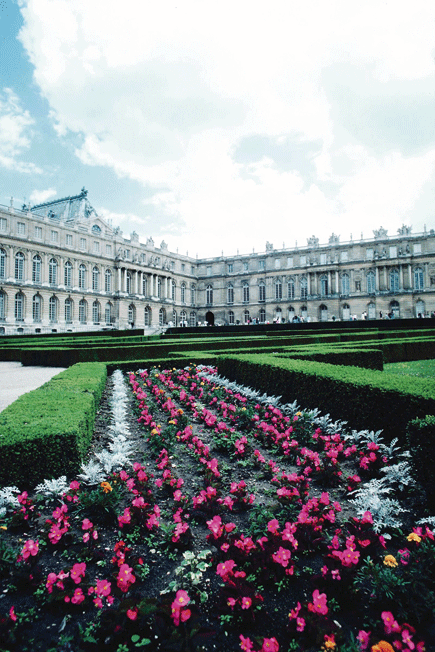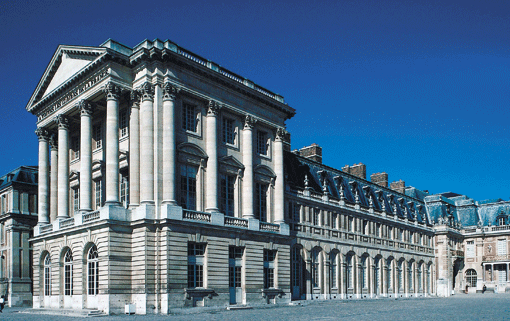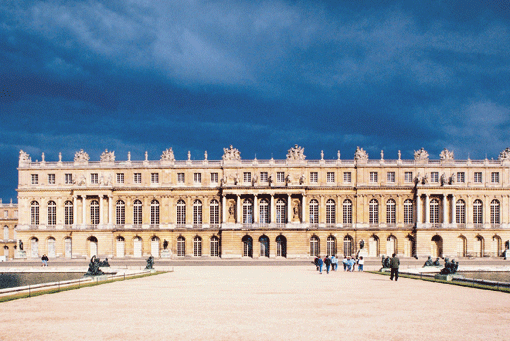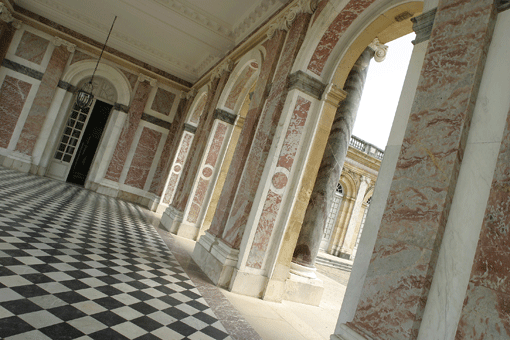
Travel
Palace of Versailles
Under the ‘King of the Sun’

When we talk about France, we should talk about the King of the Sun,
King Louis XIV and when we talk about him we need to refer to the universe which he wanted
as the galaxy of his sun shining on France and the World.
By: Sahar Soleman
The building of the Versailles Palace was his most important realized dream. This palace embodied the views and ideas of King Louis on politics. Accompany us on a tour inside the palace and its gardens to discover the history of this eternal edifice.
On the way to the palace: Sitting in the train, and seeing the paintings of famous artists that cover the wall of the station one can guess that he is at a nearby place of arts or a museum. Soon, you read the name of the station; it is Musee d’Orsay, a museum of contemporary paintings. During your journey, you cross many stations bearing the names of Paris’ locations or name of French celebrities. Your eyes enjoy the sight of rural cities which are located in a very beautiful countryside.
At the end, you reach your destination. Do not get upset with the crowded station nor elbow your way among the crowds. You should arm yourself with patience and queue up to get the palace’s brochure and the ticket that entitles you to visit all the rooms of the palace. You have to get ready for a long walk, since there are no means of transport in the palace but the carriages that carry some visitors on the pathways of the palace gardens.
As you get nearer, the scenes become clearer. As soon you cross the main gate, you can see statues and marble columns. By crossing the main gate you enter the domain of this wonderful palace.
Palace Name
The palace was named after the city it was built in. Versailles is southwest of Paris and the palace was first built in its initial form in 1624, as a hunting lodge where royal hunting expeditions started during the reign of King Louis XIV. For political reasons, he decided to abandon Paris and to reside in the lodge that was converted into what is today the Palace of Versailles. The space was doubled, and its large facade of 850 meters was built in front of the garden and during his reign it was illuminated with 3000 torches. The expansion of the palace continued during the different periods that followed.
Following the French Revolution in 1788 the royal family left the palace, and returned to Paris and in the absence of its owner, it was neglected by the remaining servants and guards and so it was repeatedly looted. Much later in 1887 Louis-Philip decided to let maintenance work be carried out and converted the palace into a museum dedicated to the history of France.
The palace witnessed many historical events. The spark of the French Revolution started there and the French army’s headquarters was based in Versailles during the Franco-Prussian war in 1871 when in that year Wilhelm I was crowned as the emperor of Germany in that palace. It was also headquarter of the House of Representatives during the Third Republic until 1879. The famous Treaty of Versailles was signed in the palace at the end of World War I in 1919. The allied forces based their headquarters in Versailles from 1944 to 1945 in World War II.
The palace contains 11 galleries dedicated to Louis XII and Louis XIV and an Opera Hall was built for the occasion of the marriage of Louis to Marie Antoinette. The palace has a Hall of Mirrors which was added it in 1678. It is 75-meter-long and 10 meter high and decorated with ceiling paintings representing French victories.
There are 17 windows in the Hall of Mirrors which overlook the park. The gardens of the palace represent one of the first examples of French garden designing. They extend over 100 hectares and contain many fountains with the most famous being the Apollo Fountain opposite the palace. The aisles of the gardens are ornamented with statues of French celebrities. The lake extends over an area of 2 kilometers long and 60 meters large. In the garden, the large Trianon Palace was built in 1687 similar to the pattern of Italian palaces. In 1769 the little Trianon was built and it was offered by Napoleon Bonaparte to his sister Pauline. In the small garden that surrounds the palace the Temple of Love was built, with its dome based on 12 columns that override a statue symbolizing love.
The Golden Fence
After passing the Golden Fence decorated with the weapons of the kings of France, you can enter the honoring courtyard where you can see many statues of Louis XIV. These statues, which astonish the eyes with their perfection, seem as if they were honor guards welcoming the visitors of different races and languages coming from all over the world. Then you enter a courtyard paved with pink marbles where you can see the little palace of Louis XIII. By turning right you reach a terrace with two large vases named the Vases of Peace and War. From this point you can stretch yourself to have a look of the gardens that was designed by Le Notre. These gardens represent an organized succession of green surfaces relaying water surfaces ornamented with fountain statues forming an artistic geometry that strikes the eyes with its gorgeousness.
Touring The Palace
In the palace, the Salon of Hercules should be visited. It derived its name from its ceiling painting. (Many paintings and statues in the palace and its gardens were inspired by the Greek and Roman myths, as was the fashion and tendency at that period.) Louis XIV was so influenced with that fashion that he asked to be called the Sun King.
The Salon of Richness and Wealth includes the rare royal acquisitions and properties within its walls. The walls of the salon are covered with magnificent cloths. King Louis was keen to decorate his palace in an extravagant and luxurious way that has been astonishing visitors throughout the ages. There is a magnificent harmony between the green color of the gardens that reflects the light of the sun in golden beams. Both the green and the golden colors overwhelm most of the palace.
The Salon of Venus is decorated in an artistic way known as deceptive art, giving the illusion that what we see is real and alive. In this salon, we can see the statues of King Louis XIV as a Roman emperor.
The Salon of Diane includes a bust of King Louis carved by the famous sculptor of his time and our time Gian Lorenzo Bernini.
The Salon of Mars has marvelous walls and ceiling paintings. This salon served as the hall of guards before it was converted to a musical lounge.
The Salon of Mercury is dedicated to the room of decorations and bedroom. On one of its walls we can see the portrait of King Louis XIV in his real size painted by artist Hyacinth Rigaud.
Salon of Apollon is the most magnificent and most opulent of all salons, but it’s no wonder because it was the home of the royal throne. The Salon of War connects the major room with the Hall of Mirrors. There are paintings in the salon that represent the victories of the King. There is also a statue of the King carved by the graver of the sculptor Kwesevuks. The statue represents the king as a Roman emperor with the victory crown on his head. Then to The Hall of Mirrors which took its name from the mirrors and glasses which are embedded in, signaling the era where this artisanal glass craft was flourishing. The hall extends 73 meters long and it is lit by 17 large windows overlooking the gardens. Each window is opposite a mirror which reflects the light, the outside colors and pictures. The ceiling paintings represent battle scenes and political stands worked by Le Brun. In this hall most marriage and engagement ceremonies of the princes and the high class people were held. Even now the major ceremonies of the Republic are held in this hall.
At the other end of the Hall of Mirrors is the Salon of Peace. It has two arcades decorated with the painting of King Louis XIV offering peace to Europe. After that we can visit the Jewel of the Palace, the Queens room where the famous Queens of France resided and lived. Marie Therese, wife of Louis XIV, Queen Mary, wife of Louis XV and the most famous Queen Marie Antoinette, wife of Louis XVI. The room of Marie Antoinette is the only room in the palace that is restored identical to it’s original shape. Both the green and golden colors overwhelm the room. The large bed beneath the big dome is decorated with a large number of ostrich feathers. The room is decorated with painting and bayonets coming from Austria, the original home of Marie Antoinette.
This gives us a clear idea of the taste and style of the life of the Queen who lived in that room. Then we may proceed to the Queen guards room, climbing the Stairs of Princes to the balcony overlooking the Orange Gardens. At each side of the orange gardens there are 100 stairs that lead to the Swiss Water Room. It was named after the Swiss band of the French army that drilled this room.
From the garden we come back to the palace to end our visit by sitting near the Neptune Basin to contemplate and relive the yesteryears of the past. The mixture of statues with faces of the visitors paint a poetic picture mixing myths with reality. During summer time, fireworks add magnificent scenes to an artistic geometry.